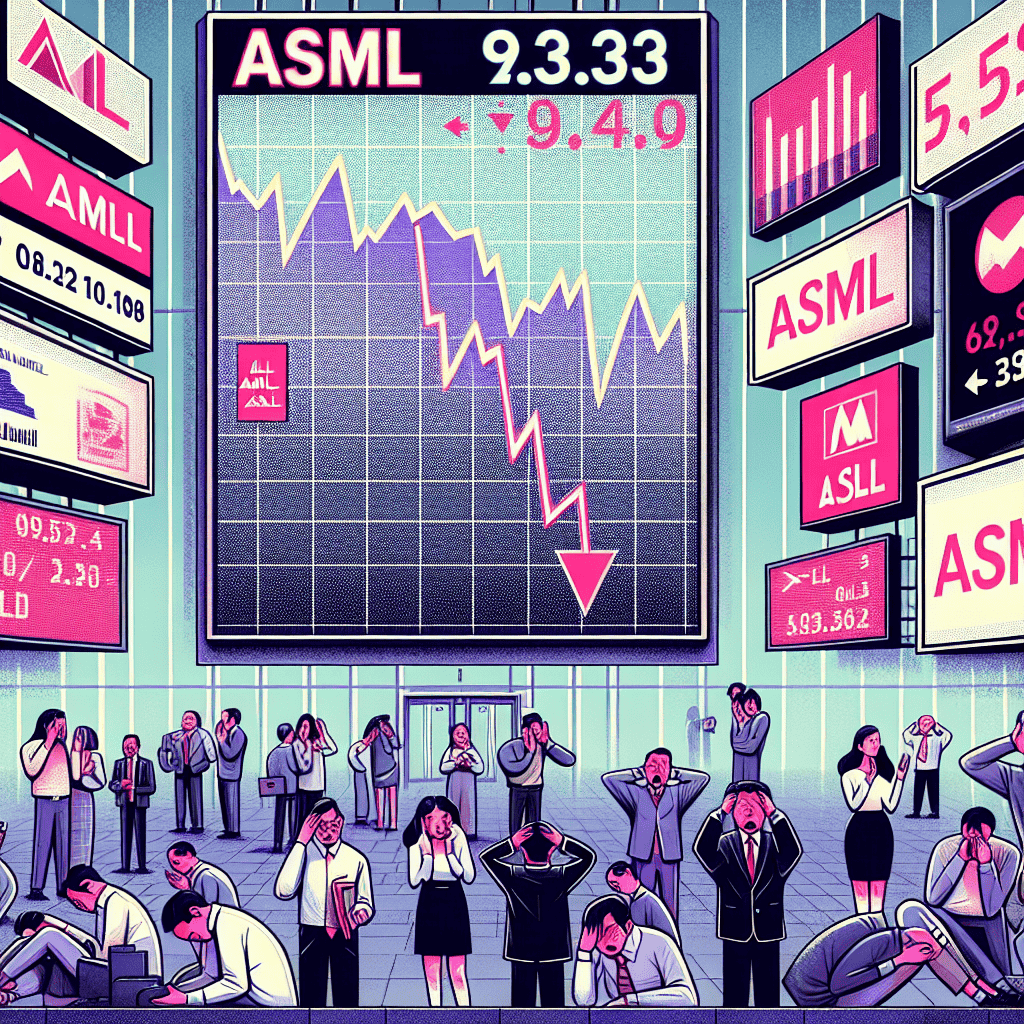“ASML Shares Tumble: Q3 Bookings Miss and Dim Outlook Shake Investor Confidence”
Introduction
ASML Holding NV, a leading supplier in the semiconductor industry, recently experienced a significant decline in its share value following the release of its third-quarter financial results. The company’s net bookings for the quarter fell short of market expectations, raising concerns among investors about its future growth prospects. Additionally, ASML’s forward-looking guidance failed to meet analysts’ forecasts, further contributing to the negative sentiment surrounding its stock. This downturn reflects broader uncertainties in the semiconductor market, as well as specific challenges faced by ASML in maintaining its growth trajectory amidst evolving industry dynamics.
Impact Of ASML’s Q3 Net Bookings Miss On Share Prices
ASML Holding NV, a pivotal player in the semiconductor industry, recently experienced a significant decline in its share prices following the release of its third-quarter financial results. The company’s net bookings for the quarter fell short of market expectations, leading to a wave of investor concern and a subsequent drop in share value. This development has sparked discussions about the broader implications for the semiconductor sector and the potential challenges ASML may face in the near future.
The semiconductor industry, known for its cyclical nature, has been under intense scrutiny as global demand fluctuates. ASML, a leader in the production of photolithography machines essential for chip manufacturing, plays a crucial role in this ecosystem. Therefore, any deviation from expected performance metrics can have a ripple effect across the market. The company’s third-quarter net bookings, which serve as an indicator of future revenue, were notably below analyst forecasts. This shortfall has raised questions about the current demand for semiconductor equipment and the potential impact on ASML’s growth trajectory.
Investors reacted swiftly to the news, resulting in a sharp decline in ASML’s share prices. The market’s response underscores the sensitivity of investor sentiment to performance metrics in the technology sector. Moreover, the disappointing outlook provided by ASML for the upcoming quarters has further fueled concerns. The company cited several factors contributing to the subdued forecast, including geopolitical tensions, supply chain disruptions, and a potential slowdown in technology spending. These elements have compounded the uncertainty surrounding ASML’s future performance, prompting investors to reassess their positions.
In addition to the immediate impact on share prices, ASML’s net bookings miss has broader implications for the semiconductor industry. As a key supplier of advanced manufacturing equipment, ASML’s performance is often seen as a bellwether for the sector. The company’s challenges may signal a potential cooling in the demand for semiconductor equipment, which could affect other players in the industry. Furthermore, the geopolitical landscape, particularly tensions between major economies, continues to pose risks to the global supply chain. These factors may lead to a more cautious approach by companies in their capital expenditure plans, potentially dampening growth prospects for equipment manufacturers.
Despite the current challenges, it is important to recognize ASML’s strong market position and technological leadership. The company remains a critical enabler of advancements in semiconductor manufacturing, particularly with its cutting-edge extreme ultraviolet (EUV) lithography technology. This technology is essential for producing the most advanced chips, which are in high demand for applications such as artificial intelligence, 5G, and high-performance computing. While short-term headwinds may impact ASML’s performance, the long-term demand for its technology is expected to remain robust.
In conclusion, ASML’s third-quarter net bookings miss and the subsequent decline in share prices highlight the volatility and complexity of the semiconductor industry. The company’s challenges reflect broader market dynamics, including geopolitical tensions and supply chain disruptions. However, ASML’s technological prowess and strategic importance in the semiconductor ecosystem provide a foundation for future growth. As the industry navigates these turbulent times, stakeholders will be closely monitoring ASML’s performance and strategic initiatives to gauge the company’s ability to adapt and thrive in an ever-evolving landscape.
Analyzing ASML’s Disappointing Outlook And Market Reaction
ASML Holding NV, a pivotal player in the semiconductor industry, recently experienced a significant decline in its share value following the release of its third-quarter financial results. The company’s net bookings fell short of market expectations, and its outlook for the coming quarters failed to inspire confidence among investors. This development has sparked a wave of concern across the financial markets, as ASML’s performance is often seen as a bellwether for the broader technology sector.
The Dutch company, renowned for its advanced lithography machines essential for semiconductor manufacturing, reported net bookings that were notably below analysts’ forecasts. This shortfall has raised questions about the demand dynamics within the semiconductor industry, which has been grappling with a complex set of challenges. These include fluctuating demand patterns, supply chain disruptions, and geopolitical tensions that have collectively contributed to an uncertain business environment.
In addition to the disappointing net bookings, ASML’s forward-looking guidance has also been a source of unease. The company projected a more cautious outlook for the upcoming quarters, citing potential headwinds that could impact its growth trajectory. This tempered forecast has been interpreted by some market participants as an indication of a potential slowdown in the semiconductor sector, which has enjoyed a period of robust growth driven by the increasing digitization of various industries.
The market’s reaction to ASML’s announcements was swift and pronounced, with the company’s shares experiencing a sharp decline. This downturn reflects the heightened sensitivity of investors to any signs of weakness in the semiconductor industry, which has been a major driver of global economic growth in recent years. The sell-off in ASML shares also underscores the broader market’s reliance on the technology sector, which has been a key pillar of strength amid economic uncertainties.
Moreover, the implications of ASML’s performance extend beyond its immediate financial results. As a critical supplier to major semiconductor manufacturers, any slowdown in ASML’s business could have ripple effects throughout the supply chain. This interconnectedness highlights the importance of ASML’s role in the global technology ecosystem and the potential consequences of its financial performance on other industry players.
Despite the current challenges, it is important to recognize that ASML remains a fundamentally strong company with a leading position in the semiconductor equipment market. Its technological prowess and strategic partnerships with major chipmakers provide a solid foundation for future growth. However, the recent developments serve as a reminder of the inherent volatility in the technology sector and the need for companies to navigate an ever-evolving landscape.
In conclusion, ASML’s recent financial results and the subsequent market reaction underscore the complexities facing the semiconductor industry. While the company’s disappointing net bookings and cautious outlook have raised concerns, it is crucial to consider the broader context in which these developments are occurring. The semiconductor sector continues to be a vital component of the global economy, and ASML’s role within it remains significant. As the industry adapts to new challenges and opportunities, stakeholders will be closely monitoring ASML’s performance and strategic initiatives to gauge the future trajectory of this critical sector.
Factors Contributing To ASML’s Q3 Performance Shortfall
ASML Holding NV, a key player in the semiconductor industry, recently experienced a significant decline in its share value following the release of its third-quarter financial results. The company’s net bookings fell short of market expectations, and its outlook for the coming months did not meet investor hopes, leading to a wave of concern among stakeholders. Several factors have contributed to this performance shortfall, each playing a crucial role in shaping the current financial landscape for ASML.
To begin with, the global semiconductor market has been facing a period of volatility, influenced by fluctuating demand and supply chain disruptions. These disruptions have been exacerbated by geopolitical tensions and trade restrictions, which have created an environment of uncertainty for companies like ASML. As a leading supplier of photolithography machines used in the production of semiconductors, ASML is particularly sensitive to these market dynamics. The company’s ability to secure new orders has been hampered by these external pressures, resulting in lower-than-expected net bookings for the quarter.
Moreover, the cyclical nature of the semiconductor industry has also played a part in ASML’s recent performance. The industry is known for its boom-and-bust cycles, where periods of high demand are often followed by downturns. Currently, the market is experiencing a slowdown after a period of rapid growth driven by increased demand for electronic devices during the pandemic. This cyclical downturn has led to a reduction in capital expenditure by semiconductor manufacturers, who are now more cautious about investing in new equipment. Consequently, ASML has seen a decline in orders for its advanced lithography systems, which are critical for the production of cutting-edge chips.
In addition to these industry-wide challenges, ASML has faced company-specific issues that have impacted its performance. The company has been grappling with production delays and cost overruns in the development of its next-generation extreme ultraviolet (EUV) lithography machines. These machines are essential for producing the most advanced semiconductors, and any setbacks in their development can have significant financial implications. The delays have not only affected ASML’s ability to fulfill existing orders but have also raised concerns about its capacity to meet future demand, further dampening investor confidence.
Furthermore, ASML’s outlook for the coming months has been less optimistic than anticipated, contributing to the decline in its share price. The company has revised its revenue projections downward, citing ongoing challenges in the supply chain and a slower-than-expected recovery in demand. This cautious outlook has been interpreted by investors as a sign that the company may continue to face headwinds in the near term, prompting a sell-off in its shares.
In conclusion, ASML’s third-quarter performance shortfall can be attributed to a combination of external market conditions and internal challenges. The semiconductor industry’s cyclical nature, coupled with supply chain disruptions and geopolitical tensions, has created a challenging environment for the company. Additionally, production delays and a cautious outlook have further compounded these difficulties, leading to a decline in investor confidence. As ASML navigates these complex issues, its ability to adapt and innovate will be crucial in determining its future success in the ever-evolving semiconductor landscape.
Investor Sentiment Following ASML’s Share Price Decline

ASML Holding NV, a pivotal player in the semiconductor industry, recently experienced a significant decline in its share price following the release of its third-quarter financial results. The company’s net bookings fell short of market expectations, and its outlook for the coming quarters did little to assuage investor concerns. This development has sparked a wave of reactions among investors, analysts, and market observers, all of whom are keenly assessing the implications of ASML’s performance on the broader semiconductor sector.
The semiconductor industry, known for its cyclical nature, has been under intense scrutiny as global demand for chips continues to fluctuate. ASML, as a leading supplier of photolithography machines essential for chip manufacturing, is often seen as a bellwether for the industry’s health. Therefore, any deviation from expected performance metrics can have a ripple effect, influencing investor sentiment and market dynamics. The recent shortfall in ASML’s net bookings, which are indicative of future revenue potential, has raised questions about the demand trajectory for semiconductor equipment.
In the wake of the disappointing financial results, ASML’s management has attempted to provide clarity and context. They have pointed to a combination of factors, including macroeconomic uncertainties and shifts in customer demand, as contributing to the lower-than-expected bookings. While these explanations offer some insight, they have not entirely mitigated investor concerns. The company’s cautious outlook for the upcoming quarters has further fueled apprehension, as it suggests potential headwinds that could impact future growth.
Investor sentiment, a critical driver of stock market performance, has been notably affected by ASML’s recent announcements. The decline in share price reflects a broader unease among investors, who are now reevaluating their positions in light of the new information. Some investors may perceive this as an opportunity to reassess their portfolios, while others might view it as a temporary setback in an otherwise robust long-term growth story. The divergence in investor reactions underscores the complexity of the current market environment, where uncertainty and volatility are prevalent.
Moreover, the impact of ASML’s performance extends beyond its immediate stakeholders. The semiconductor industry, which has been grappling with supply chain disruptions and geopolitical tensions, is closely monitoring ASML’s situation. As a key supplier, any challenges faced by ASML could have downstream effects on chip manufacturers and, by extension, the technology sector at large. This interconnectedness highlights the importance of ASML’s role in the global technology ecosystem and the potential implications of its financial health.
In conclusion, ASML’s recent share price decline, driven by missed net bookings and a cautious outlook, has prompted a reevaluation of investor sentiment. While the company remains a critical player in the semiconductor industry, the current challenges it faces have introduced a degree of uncertainty that investors must navigate. As the market continues to digest the implications of ASML’s performance, stakeholders will be closely watching for any signs of stabilization or further volatility. Ultimately, the situation serves as a reminder of the intricate dynamics at play in the semiconductor sector and the broader market, where shifts in sentiment can have far-reaching consequences.
Long-term Implications Of ASML’s Q3 Results On The Semiconductor Industry
ASML Holding NV, a pivotal player in the semiconductor industry, recently experienced a significant decline in its share value following the release of its third-quarter results. The company’s net bookings fell short of market expectations, and its outlook for the coming quarters has left investors and industry analysts concerned. This development raises important questions about the long-term implications for both ASML and the broader semiconductor industry, which relies heavily on the company’s advanced lithography equipment.
To understand the potential impact, it is essential to consider ASML’s role in the semiconductor supply chain. ASML is the leading supplier of photolithography machines, which are crucial for the production of semiconductor chips. These machines are used to etch intricate patterns onto silicon wafers, a process that is fundamental to chip manufacturing. ASML’s cutting-edge technology, particularly its extreme ultraviolet (EUV) lithography systems, has enabled the production of smaller, more powerful, and energy-efficient chips. Consequently, any fluctuations in ASML’s performance can have a ripple effect throughout the semiconductor industry.
The recent shortfall in ASML’s net bookings suggests a potential slowdown in demand for its equipment. This could be attributed to several factors, including macroeconomic uncertainties, shifts in consumer demand, and geopolitical tensions affecting global supply chains. As semiconductor manufacturers reassess their capital expenditures in response to these challenges, ASML may face a period of reduced order volumes. This situation could lead to a temporary deceleration in the pace of technological advancements within the industry, as companies may delay investments in new equipment.
Moreover, ASML’s cautious outlook for the future has added to the uncertainty. The company has indicated that it expects a moderation in growth rates, which could signal a broader trend of stabilization in the semiconductor market. While this may alleviate some of the supply chain pressures that have plagued the industry in recent years, it also raises concerns about the potential for reduced innovation and competitiveness. If semiconductor manufacturers scale back their investments in cutting-edge technology, it could hinder the industry’s ability to meet the growing demand for advanced chips used in applications such as artificial intelligence, 5G, and autonomous vehicles.
However, it is important to recognize that the semiconductor industry is inherently cyclical, and periods of slower growth are not uncommon. ASML’s strong market position and technological leadership provide a solid foundation for navigating these challenges. The company’s continued focus on research and development, along with its commitment to expanding its production capacity, suggests that it is well-prepared to capitalize on future opportunities. As the industry eventually rebounds, ASML is likely to play a crucial role in driving the next wave of innovation.
In conclusion, while ASML’s disappointing third-quarter results and cautious outlook have raised concerns about the immediate future, the long-term implications for the semiconductor industry are more nuanced. The current challenges may lead to a temporary slowdown in technological progress, but they also present an opportunity for the industry to recalibrate and address underlying issues. As ASML and its partners work to overcome these obstacles, the semiconductor industry is poised to emerge stronger and more resilient, ready to meet the demands of an increasingly digital world.
Comparing ASML’s Q3 Performance With Competitors
ASML Holding NV, a key player in the semiconductor industry, recently experienced a significant drop in its share price following the release of its third-quarter financial results. The company’s net bookings fell short of market expectations, and its outlook for the coming quarters did little to assuage investor concerns. This development has prompted a closer examination of ASML’s performance in comparison to its competitors, shedding light on the broader dynamics within the semiconductor sector.
To begin with, ASML’s third-quarter results revealed a notable decline in net bookings, a critical indicator of future revenue. This shortfall was unexpected, given the company’s strong position in the market as a leading supplier of photolithography machines, which are essential for semiconductor manufacturing. The disappointment was further compounded by a cautious outlook for the upcoming quarters, which suggested that the company might face ongoing challenges in maintaining its growth trajectory.
In contrast, some of ASML’s competitors have managed to navigate the current market conditions more effectively. For instance, companies like Applied Materials and Lam Research have reported relatively stable performances, buoyed by their diversified product portfolios and strategic investments in emerging technologies. These firms have capitalized on the growing demand for advanced semiconductor equipment, driven by the proliferation of 5G technology, artificial intelligence, and the Internet of Things. As a result, they have been able to maintain investor confidence, even amid broader market uncertainties.
Moreover, the semiconductor industry as a whole is grappling with a complex set of challenges, including supply chain disruptions, geopolitical tensions, and fluctuating demand patterns. These factors have created a volatile environment, making it increasingly difficult for companies to forecast future performance accurately. In this context, ASML’s cautious outlook can be seen as a prudent response to the unpredictable market landscape. However, it also highlights the need for the company to adapt its strategies to remain competitive.
One area where ASML has traditionally excelled is in its technological innovation. The company’s cutting-edge extreme ultraviolet (EUV) lithography machines are considered a game-changer in the industry, enabling the production of smaller and more powerful chips. Despite the recent setbacks, ASML’s continued investment in research and development positions it well to capitalize on future technological advancements. Nevertheless, the company must also address the immediate concerns of its investors by demonstrating a clear path to recovery and growth.
In comparison, competitors like Tokyo Electron have also been investing heavily in research and development, focusing on enhancing their product offerings and expanding their market reach. These efforts have allowed them to capture a larger share of the market, particularly in regions where demand for semiconductor equipment is on the rise. By contrast, ASML’s reliance on a narrower product range may have contributed to its recent struggles, underscoring the importance of diversification in a rapidly evolving industry.
In conclusion, ASML’s third-quarter performance and subsequent share price decline serve as a reminder of the challenges facing the semiconductor industry. While the company remains a leader in technological innovation, it must navigate a complex and uncertain market environment to maintain its competitive edge. By learning from the strategies of its competitors and adapting to changing market conditions, ASML can work towards regaining investor confidence and securing its position as a key player in the global semiconductor landscape.
Strategies For Investors In Light Of ASML’s Recent Challenges
In the wake of ASML’s recent financial disclosures, investors are grappling with the implications of the company’s underwhelming third-quarter performance. The semiconductor equipment giant, known for its cutting-edge lithography machines, reported net bookings that fell short of market expectations, leading to a significant drop in its share price. This development has prompted a reevaluation of investment strategies, as stakeholders seek to navigate the challenges posed by ASML’s current outlook.
To begin with, it is essential for investors to understand the broader context in which ASML operates. The semiconductor industry is characterized by rapid technological advancements and cyclical demand patterns. ASML’s position as a leader in the production of extreme ultraviolet (EUV) lithography systems places it at the forefront of innovation, yet it also subjects the company to the volatility inherent in the tech sector. Consequently, fluctuations in ASML’s financial performance are not uncommon, and investors must be prepared to adapt their strategies accordingly.
In light of the recent downturn, diversification emerges as a prudent approach for investors. By spreading investments across a range of assets, individuals can mitigate the risks associated with a single company’s performance. This strategy not only provides a buffer against potential losses but also allows investors to capitalize on opportunities in other sectors that may be experiencing growth. For instance, while ASML’s short-term outlook may be uncertain, other areas within the technology industry, such as artificial intelligence or renewable energy, could offer promising returns.
Moreover, it is crucial for investors to maintain a long-term perspective. Despite the current challenges, ASML’s technological prowess and strategic importance in the semiconductor supply chain suggest that the company is well-positioned for future growth. Investors who focus on the long-term potential of ASML’s innovations may find that the present dip in share price represents a buying opportunity. By adopting a patient approach, stakeholders can potentially benefit from the company’s eventual recovery and continued leadership in the industry.
Additionally, staying informed about industry trends and ASML’s strategic initiatives is vital. The semiconductor landscape is constantly evolving, with new technologies and market dynamics shaping the competitive environment. Investors should pay close attention to ASML’s efforts to expand its product offerings, enhance operational efficiency, and strengthen partnerships with key players in the industry. By keeping abreast of these developments, investors can make more informed decisions and adjust their strategies to align with ASML’s evolving business model.
Furthermore, it is advisable for investors to engage in regular portfolio reviews. By periodically assessing the performance of their investments, individuals can identify areas that require adjustment and ensure that their portfolios remain aligned with their financial goals. In the case of ASML, this might involve reevaluating the weight of the company’s shares within the portfolio or considering alternative investments that offer a more favorable risk-reward profile.
In conclusion, while ASML’s recent challenges have undoubtedly raised concerns among investors, they also present an opportunity to refine investment strategies. By embracing diversification, maintaining a long-term perspective, staying informed about industry trends, and conducting regular portfolio reviews, investors can navigate the current landscape with greater confidence. As the semiconductor industry continues to evolve, those who adopt a proactive and informed approach will be better positioned to capitalize on the opportunities that lie ahead.
Q&A
1. **What caused ASML shares to plunge recently?**
ASML shares plunged due to Q3 net bookings missing estimates and a disappointing outlook.
2. **What are net bookings, and why are they important for ASML?**
Net bookings refer to the total value of new orders received, minus any cancellations. They are important for ASML as they indicate future revenue potential and demand for their products.
3. **How did ASML’s Q3 net bookings compare to expectations?**
ASML’s Q3 net bookings were below market expectations, contributing to the decline in share price.
4. **What specific outlook from ASML disappointed investors?**
Investors were disappointed by ASML’s guidance for future quarters, which suggested slower growth or potential challenges in meeting previous forecasts.
5. **How did the market react to ASML’s Q3 performance and outlook?**
The market reacted negatively, leading to a significant drop in ASML’s share price.
6. **What impact does ASML’s performance have on the semiconductor industry?**
As a major supplier of photolithography equipment to the semiconductor industry, ASML’s performance can signal broader trends and potential slowdowns in semiconductor manufacturing and demand.
7. **What are analysts saying about ASML’s future prospects following the Q3 report?**
Analysts may have mixed views, with some expressing concern over the missed estimates and outlook, while others might focus on long-term growth potential and technological leadership.
Conclusion
ASML shares experienced a significant decline following the company’s announcement that its third-quarter net bookings fell short of market expectations. This shortfall, coupled with a disappointing outlook, has raised concerns among investors about the company’s future growth prospects. The miss in net bookings suggests potential challenges in demand or market conditions, which could impact ASML’s revenue and profitability in the near term. Consequently, investor sentiment has been negatively affected, leading to a sell-off in the company’s stock. The situation underscores the importance of meeting market expectations and maintaining a positive outlook to sustain investor confidence.





